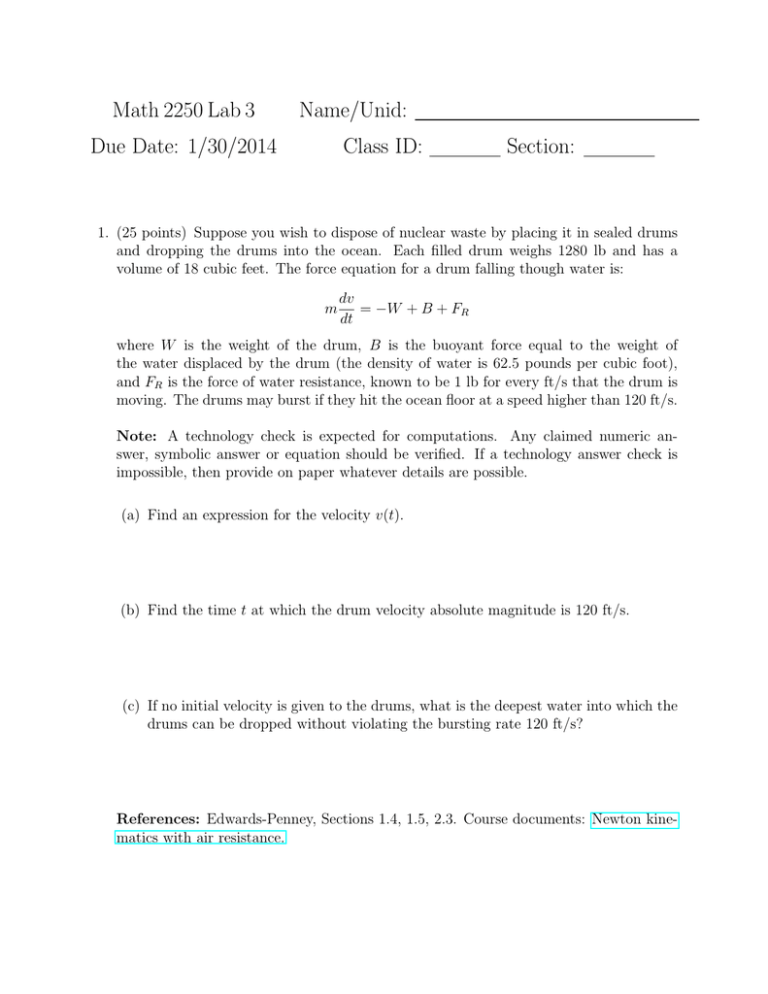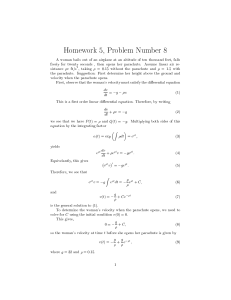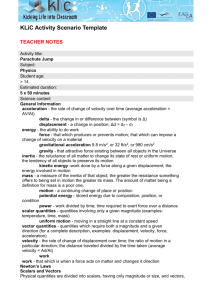Math 2250 Lab 3 Name/Unid: Due Date: 1/30/2014 Class ID:
advertisement

Math 2250 Lab 3 Name/Unid: Due Date: 1/30/2014 Class ID: Section: 1. (25 points) Suppose you wish to dispose of nuclear waste by placing it in sealed drums and dropping the drums into the ocean. Each filled drum weighs 1280 lb and has a volume of 18 cubic feet. The force equation for a drum falling though water is: m dv = −W + B + FR dt where W is the weight of the drum, B is the buoyant force equal to the weight of the water displaced by the drum (the density of water is 62.5 pounds per cubic foot), and FR is the force of water resistance, known to be 1 lb for every ft/s that the drum is moving. The drums may burst if they hit the ocean floor at a speed higher than 120 ft/s. Note: A technology check is expected for computations. Any claimed numeric answer, symbolic answer or equation should be verified. If a technology answer check is impossible, then provide on paper whatever details are possible. (a) Find an expression for the velocity v(t). (b) Find the time t at which the drum velocity absolute magnitude is 120 ft/s. (c) If no initial velocity is given to the drums, what is the deepest water into which the drums can be dropped without violating the bursting rate 120 ft/s? References: Edwards-Penney, Sections 1.4, 1.5, 2.3. Course documents: Newton kinematics with air resistance. 2. (25 points) Paratrooper with Linear Drag A paratrooper bails out of an airplane at altitude 15,000 ft, then falls freely for 30 seconds, then opens a parachute. Assume linear air resistance kv ft/s2 with drag coefficient ρ=0.4 before the parachute opens and ρ= 4 after the parachute opens. Note: A technology check is expected, as in the previous problem. (a) Write down the ODE for velocity v of the paratrooper before the parachute opens. (b) Find the velocity at time 5 seconds and the velocity at time 30 seconds, when the paratrooper just opens the parachute. (c) Find the height when the paratrooper opens the parachute. (d) Explain why w0 = −32 − 4w, w(0) = v(30) ≈ −80 is the model for the paratrooper’s descent after the parachute opens. (e) Explain why the total time of descent for the paratrooper is t = 30 + 1598 = 1628s. Reference: Edwards & Penney Section 2.3. This traditional parachute problem can be modified to be more realistic. Read Meade & Struthers (1999) Differential Equations in the New Millennium: the Parachute Problem, Int. J. Engng Ed. 15(6), 417-424. Retrieved on January 14, 2014. See also Meade, D (1998), ODE Models for the Parachute Problem, SIAM Review. 40(2). 327-332. Retrieved on January 14, 2014 at Page 2








